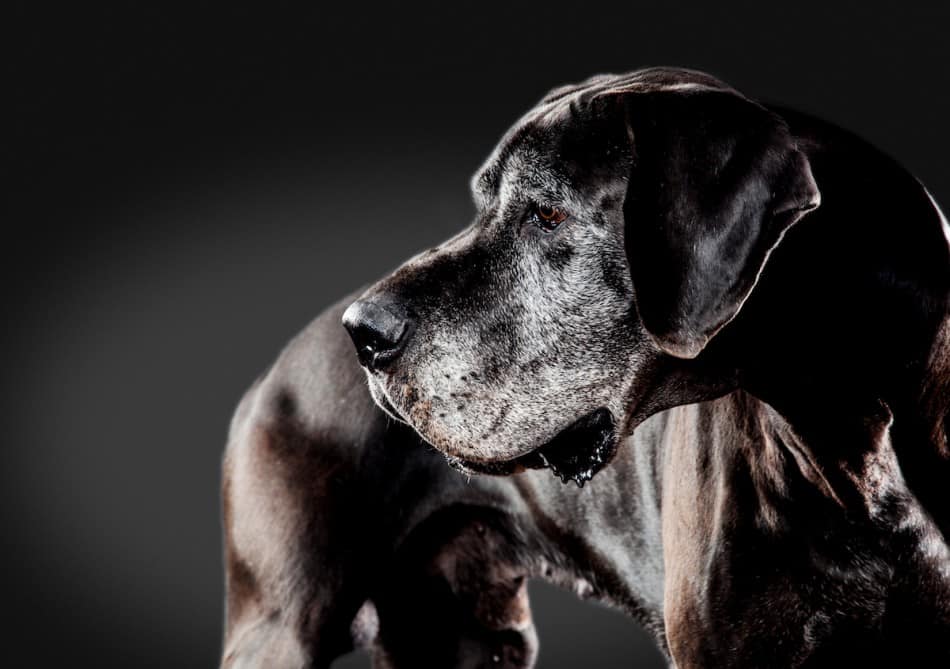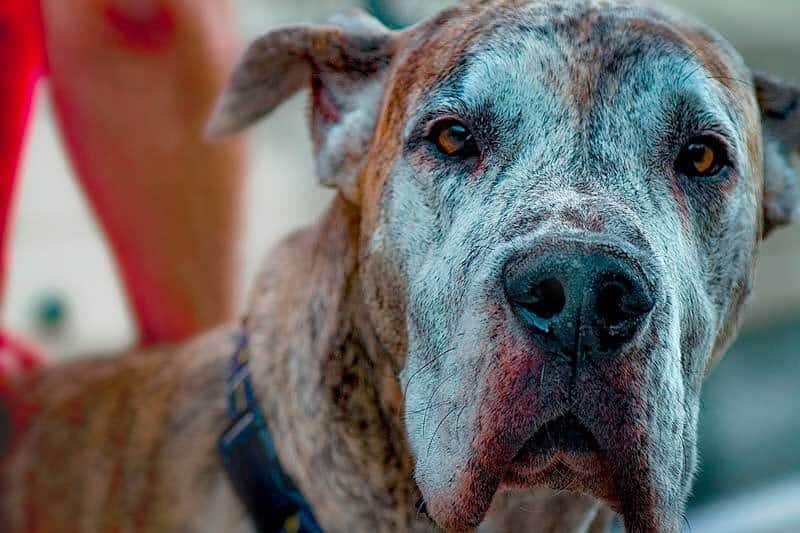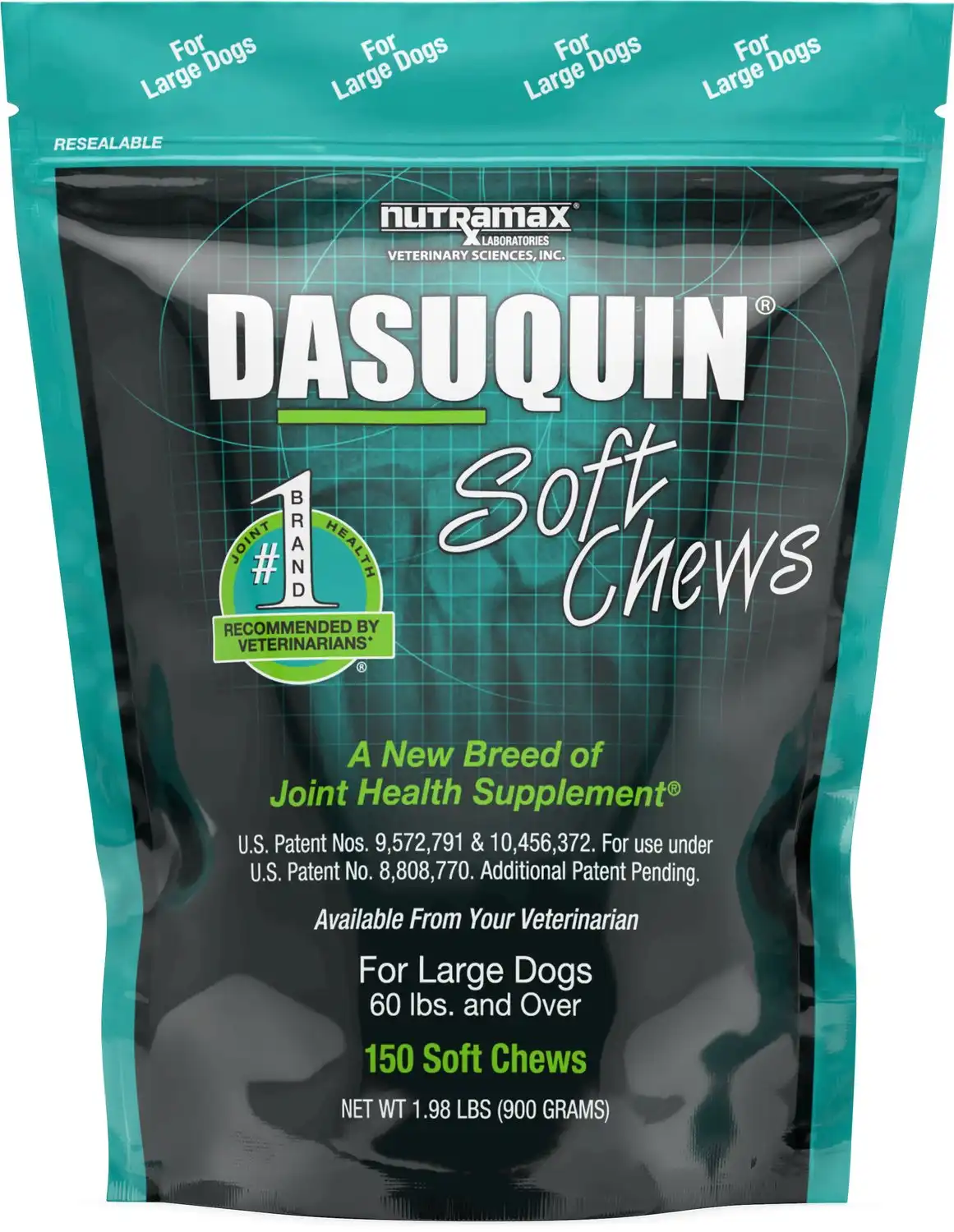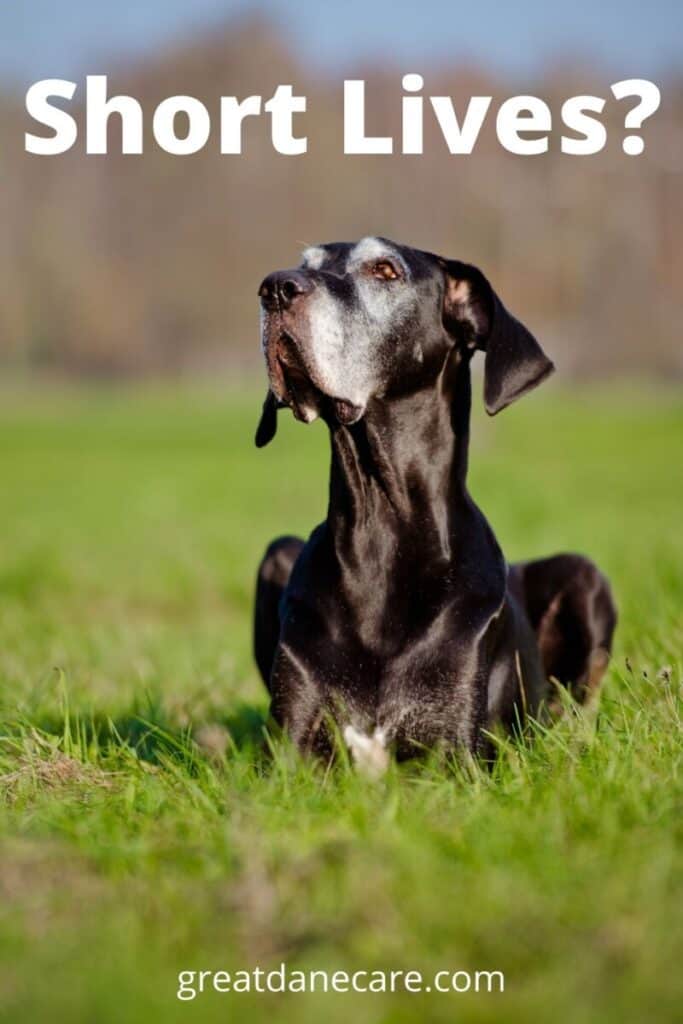
This post contains affiliate links and I will be compensated if you make a purchase after clicking on my links.
Do you have an older Great Dane? While sometimes these can live until they are ten years old, this breed usually dies between 7 and 10.
With such a short life compared to other dogs, we got to wondering why do Great Danes have a short life span and is there anything that we can do so that they can live longer.
Why Do Great Danes Have Short Lives?
Great Danes tend to live shorter lives due to the increased risk of certain diseases such as Bloat, Dilated Cardiomyopathy, and Cancer.
The oldest Great Dane ever recorded live to be about 15 years old!
While the average life span is 7 to 10 years old, there are many things that you can do to help your Great Dane live a long and happy life.
What do Great Danes usually die from?
Great Danes are prone to many different types of diseases. Some of these diseases can be life-threatening.
These are a few of the most common diseases that we see in Great Danes that can decrease their life.
Gastric Dilation and Volvulus (GDV) or BLOAT

The medical term for bloat is Gastric Dilation and Volvulus.
This means that your Great Dane’s stomach has become enlarged with air, flipped over, and twisted on itself. This usually causes an obstruction of the outflow of the stomach.
Once your Great Dane’s stomach has twisted, their stomach will quickly become distended and full of air causing your dog to look “bloated”.
Common signs of bloat in a Great Danes are:
- Hard, distended or bloated abdomen
- Retching
- Painful abdomen
- Excessive Drooling
- Pacing
- Increased Heart Rate or Pulse
- Collapse
If your Great Dane has bloated, they need to go to your vet as soon as possible or the emergency clinic if your vet is closed. Bloat is a life-threatening emergency.
This condition will usually need surgery. Bloating may cause a blockage in your Great Dane’s GI tract, which can be very painful.
Bloat cannot be treated at home.
Your vet will want to take x-rays of your dog’s stomach to see if the stomach is twisted over. If your Great Danes stomach is twisted, they will need to do emergency surgery and untwist your dog’s stomach.
Once they have twisted their stomach back over, your vet will sew their stomach in place to prevent the stomach from twisting over again.
There are many precautions that you should take to prevent your Great Dane from bloating. No matter how many preventative measures that you take, some dogs will bloat.
It is best to feed your Great Dane small and frequent meals 2 to 3 times a day. This will help reduce the chance of them developing bloat.
After your Great Dane eats, make them rest for about one hour. This helps to make sure that their food is fully digested.
Bloat can be a very scary and life-threatening condition that will need immediate veterinary care. With proper care and prevention, many Great Danes who are prone to bloat can have certain lifestyle modifications to help reduce their chance of bloating.
Osteosarcoma or Bone Cancer

Osteosarcoma is a common cancer seen in large breed dogs such as Great Danes and Mastiffs. These dogs develop a swollen area around the wrist, shoulder, or knee.
The areas are usually very hard to the touch and can even be very painful. Many times, Osteosarcoma is treated by removing the affected leg, chemotherapy, and radiation.
Sometimes this is not possible due to the size of your Great Dane not being able to function on three legs and the cost of these procedures. Usually, this type of cancer is very aggressive and carries a very poor prognosis.
There are also other types of cancer your Great Dane can get as they get older. When you are playing with your Great Dane, you may notice new lumps and bumps on their body.
These may just be fatty mass, but they can also be cancerous. It would be best for your vet to look at these masses. They can take a small sample of the mass and look at the sample of cells under a microscope.
This will help determine if this mass is cancerous or not. There are signs that you can look for that would indicate that your Great Dan may have cancer, such as:
- Vomiting
- Diarrhea
- Losing Weight
- Seeing a growth on your dog
If you notice any of these signs, have your vet examine your Great Dane to see if they have cancer. Your vet can also help you decide on the best possible treatment for your dog.
Dilated Cardiomyopathy DCM
Older Great Danes can suffer from heart disease. A common heart disease they get is Dilated Cardiomyopathy. This is when the heart grows bigger.
The muscle walls of the heart get thinner and are not able to function as they should. As your Great Dane gets older, its heart may no longer function as it should.
Common signs associated with heart problems are:
- Coughing especially after they have been outside playing
- Trouble breathing
- Falling over after bouts of energy
Your vet can listen to your Great Dane’s heart to see if they have a heart murmur. Your vet will also listen to their lungs since some heart diseases can also cause problems with your Great Danes’s lungs.
A heart murmur would indicate that there may be something wrong with your dog’s heart.
If your Great Dane does have signs of heart disease, your vet may want to run tests on your dog’s heart. The most common tests that your vet may suggest that you run are chest x rays, Echocardiogram (an ultrasound of the heart), and an EKG.
The test results will help your vet figure out how progressed their heart disease is. Once they figure out exactly what is wrong with your Great Dane’s heart, there are medications that your dog can be started on.
These medications will help your Great Dane’s heartbeat more effectively and decrease any fluid in the chest and abdomen.
More recent studies have also found that grain-free diets have also led to higher occurrence rates of DCM. For this reason, we do not generally recommend a grain-free diet for Great Danes unless there are extenuating medical circumstances. More on our food approach can be found here.
Arthritis
If your Great Dane has hip or elbow dysplasia when they are younger, as they age, they can develop arthritis. Even if your Great Danes do not have these diseases, they can develop arthritis as they age.
A dog with arthritis will have problems with moving around comfortably. They will have problems getting up, limping, and even not using one leg.
Arthritis is very commonly seen in Great Danes that are overweight.
Keeping your Great Dane at a healthy lean body weight can help decrease the amount of pain your Great Dane has from arthritis.
If your Great Dane is ever limping around for more than one day, it would be best to make an appointment with your vet so you can figure out what is causing your Great Dane to show these signs.
Common signs seen with arthritis and joint pain in Great Danes are:
- Limping
- Difficulty walking
- Problems standing, especially after laying down for a long time
- Crying out in pain
Your vet can prescribe your Great Dane many different medications and joint supplements to reduce the pain and inflammation in your Great Dane’s joints.
Dasuquin is the #1 joint health brand recommended by veterinarians and combines the demonstrated benefits and synergies of ASU, glucosamine, and chondroitin sulfate. Convenient soft chews provide a simplified, tasty experience for supporting your dog’s joint health!
There may be surgical procedures to permanently fix the joint problem. This would depend on what is causing your Great Dane’s problems.
Make an appointment with your vet, and they can help figure out the cause of your Great Dane’s problem and prescribe them medication to help decrease the pain from their arthritis.
Obesity
Obesity is very often seen in older Great Danes. As your dog starts to age, its metabolism slows down just like it does in people.
When your Great Dane’s metabolism slows down, you should also start to decrease the amount of food you are feeding them just a little bit. This will help prevent them from becoming overweight.
Many people do not decrease the amount of food that they are feeding their older Great Danes.
This will quickly cause these dogs to become obese. Most dogs do not know to stop eating when they are full. They will usually eat whatever is in front of them until it is all gone.
This will cause your Great Dane to put on a few extra pounds and cause many other health problems such as:
- Joint pain and arthritis
- Liver and kidney problems
- Heart problems
- Problems breathing
There are many things that you can do to help your Great Dane lose weight, such as increasing their exercise time.
When you take them out for a walk, take them for a little longer walk or a little faster walk. Even a short jog around the block!
You can also take them to the local dog park and throw a ball for them to chase. At the dog park, there will be other dogs for your Great Dane to play with to help them exercise more while you sit and watch.
You can also help your Great Dane lose weight by decreasing the amount of food that you are feeding them. It is best to start by decreasing their food by small amounts such as a 10% daily reduction, or possibly 20% for very overweight dogs.
This will quickly help them shed those few extra pounds. If you’re concerned that your Great Dane is overweight, then make sure to take a look at our article here for more tips.
Why do bigger dogs live shorter lives?
For better or for worse, this is actually a scientific mystery!
Most of our large animals, such as elephants and whales, live very long lives whereas smaller animals such as mice only live a few years.
You would think that a larger dog would live much longer than smaller dogs if this held true with all animals.
However, Great Danes usually on like 7 to 10 years. We very rarely see a Great Dane liver over ten years of age, even with the best care possible.
Do female Great Danes live longer?
Female Great Danes do tend to live a little longer than male Great Danes. This is not a huge difference that should cause you to not want to have a male Great Dane.
Since they are usually a little smaller in size than male Great Danes, this is believed to be why they live a little longer than males.
Since Great Danes can vary in size just a little, we also see Great Danes, who are on the smaller side, tend to also live a little longer.
Great Dane old age symptoms
There are many different signs that you would first start to notice as your Great Dane starts to get older.
Always be on the lookout for any signs of illness in your Great Dane.
Common signs that would indicate that your Great Dane would need to see your vet as soon as possible is:
- Vomiting or Diarrhea that lasts for more than one day
- Limping or trouble moving around
- Not eating
- Coughing
- Drooling
- Blood coming from anywhere
- Just not acting normal
As soon as you notice any of these signs, it is best to take your Great Dane to your vet.
They can examine your dog and figure out what is causing these problems in your Great Dane and start treatment before they get very sick.
How to Make Great Danes Live Longer
There are many things that we can control in our dog’s life that can help them live a longer, healthier, and happier life.
There are things out of our control, such as their genetics.
These are a few things that you can do to help your Great Dane live a long and happy life.
Breeding Responsibly
If you get your Great Dane from a responsible breeder that can provide you with a history of the parent’s health, make sure the puppy that you chose comes from a line that has had testing done for hip and elbow dysplasia.
They can also have the parents tested for heart problems, eye problems, or other genetic diseases.
When adopting from a rescue group, you will not always know their background. You can have your vet examine your new Great Dane as soon as you get them and look for any signs of health problems.
A Good Diet
What you feed your Great Dane is crucial to their overall health. This is very important when they are a puppy!
Great Danes have special food requirements to prevent them from growing too fast.
If your Great Dane grew too fast, this would lead to musculoskeletal diseases such as hip dysplasia, osteochondrosis, and hypertrophic osteodystrophy.
Once your Great Dane is grown, their diet and exercise will play a key role in keeping them healthy. Great Danes can easily turn into large couch potatoes and become obese.
Obesity is a very serious problem for giant breed dogs. This can take years off their lives. A dog that is obese will have many health problems such as arthritis, diabetes, and other orthopedic problems.
Make sure that you are feeding your Great Dane the appropriate amount of food and that they get regular exercise. This will help them stay in shape and live a long, happy life.
Frequent Vet Visits
While some diseases in Great Danes are very hard to prevent, many things can easily be prevented or caught early with frequent vet visits. If you catch a disease early, the chases of a full recovery are very good.
Great Danes are very big dogs, which can also mean a much bigger veterinary bill. The added expense is not a reason that you should skip your Great Dane’s regular checkup.
Keep your dog up to date on all vaccines. During these visits, make sure to let your veterinarian know of s any changes in their activity levels, appetite, or mood.
These changes can be a sign of illness.
Your vet can also help you manage any joint problems, such as arthritis, that commonly develop as your Great Dane ages.
Spay or Neuter Your Great Dane
Intact female and male dogs tend to die earlier than spayed or neutered Great Danes. More information about when to spay or neuter your Great Dane can be found in our article here.
When you spay your female dog, you have removed any chances of uterine disease such as pyometra and uterine or breast cancer. Male dogs who are not neutered tend to get out of the backyard and get into trouble.
With all the extra testosterone, they are looking for a mate. This will cause them to get hit by a car or even get in a fight with other dogs.
Having your Great Dane spayed or neutered will help them live a longer and happier life.
Final Thoughts on Great Dane Life Expectancy
Great Danes unfortunately, do not live as long as many smaller dog breeds. However, there are some things that you can do to help prevent certain diseases in your Great Dane and help them live as long as possible!
With a life expectancy of 7 to 10 years, consider yourself lucky if you get to spend 10+ years with your Great Dane. Sometimes unexpected tragedies happen that take our beloved Great Danes from us much earlier than expected.
Diseases such as bloat, heart problem, joint problems, or cancer do not know an age limit and can happen at any time.



Gastric Dilatation and Volvulus (GDV)GVD/Torsion , commonly called torsion or bloat is very dangerous, a dog may not recover from the corrective procedure (especially an older dog). It’s a very hard way for a dog to die. You don’t want this to happen.
The best thing is to get a preventative gastropexy done before the dog gets GVD. In a female it most certainly should be done if she is spayed. Otherwise a Laparoscopic gastropexy is a minimally invasive procedure that allows the surgeon to perform a gastropexy through much smaller incisions than the traditional approach.
I had a Laparoscopic gastropexy done on my male — he recovered from procedure in days. When my female was spayed I had her done. It was a bit expensive but worth it.
My female Great Dane will be a year at the end of September. How long after turning a year old should I wait to have her spayed? (We’re going to have her stomach tacked at the same time)
We did our female Great Dane’s gastropexy and spaying a few weeks after turning 6 months old. Talk to your veterinarian to see what would be a good time to have it done. They usually will have a full health history of your dog.